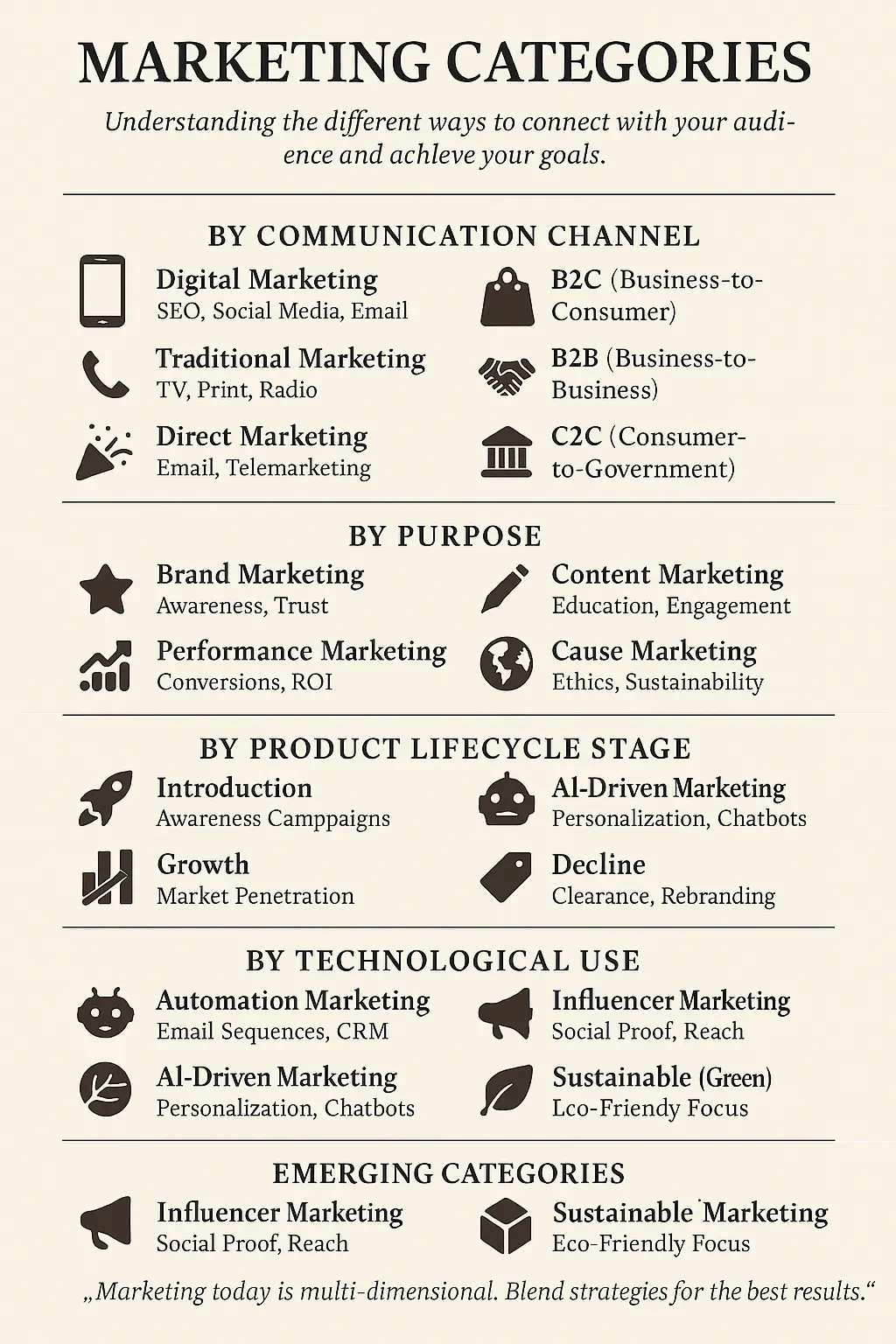Marketing, as a broad and complex discipline, is divided into various categories based on function, medium, audience, and purpose. These categories help businesses focus their strategies, target the right audiences, and measure outcomes effectively. Understanding these categories is essential for designing an integrated and successful marketing strategy.
Let’s explore them in depth:
1. Based on Function
1.1. Strategic Marketing
- Definition: Long-term planning that aligns marketing goals with business objectives.
- Example: Market segmentation, targeting, and positioning (STP model).
1.2. Operational (Tactical) Marketing
- Definition: Day-to-day activities and campaigns that execute the strategy.
- Example: Running ads, social media posts, event promotions.
1.3. Analytical Marketing
- Definition: The use of data and analytics to guide marketing decisions.
- Example: Google Analytics for web traffic, customer insights, conversion rates.
2. Based on Communication Channel
2.1. Traditional Marketing
- Definition: Offline methods of promotion.
- Examples: TV ads, print media, billboards, radio commercials.
2.2. Digital Marketing
- Definition: Promotion using online platforms.
- Examples: SEO, social media marketing, email marketing, PPC advertising.
2.3. Direct Marketing
- Definition: Direct communication with targeted customers.
- Examples: Email newsletters, SMS campaigns, telemarketing.
2.4. Event Marketing
- Definition: Promotion through events to engage audiences.
- Examples: Trade shows, webinars, product launches.
2.5. Guerrilla Marketing
- Definition: Unconventional, creative strategies for high impact.
- Example: Flash mobs, street art campaigns.
3. Based on Audience
3.1. B2C (Business-to-Consumer) Marketing
- Focus: Reaching individual consumers.
- Example: A fashion brand promoting its latest collection.
3.2. B2B (Business-to-Business) Marketing
- Focus: Targeting other businesses.
- Example: A SaaS company marketing its project management software.
3.3. C2C (Consumer-to-Consumer) Marketing
- Focus: Facilitating consumer interactions.
- Example: Platforms like eBay or Facebook Marketplace.
3.4. B2G (Business-to-Government) Marketing
- Focus: Targeting governmental organizations.
- Example: Companies bidding for government contracts.
4. Based on Purpose
4.1. Brand Marketing
- Goal: Build and maintain brand recognition and loyalty.
- Example: Coca-Cola’s global branding campaigns.
4.2. Performance Marketing
- Goal: Focus on measurable results like clicks, conversions, and sales.
- Example: Affiliate marketing, pay-per-click campaigns.
4.3. Relationship Marketing
- Goal: Build long-term relationships with customers.
- Example: Loyalty programs, personalized email sequences.
4.4. Content Marketing
- Goal: Attract and engage customers through valuable content.
- Example: Blogs, videos, podcasts, infographics.
4.5. Cause Marketing
- Goal: Support social causes while promoting the brand.
- Example: TOMS’ “One for One” campaign (donating a pair of shoes for each sold).
5. Based on Product Lifecycle Stage
5.1. Introduction Stage Marketing
- Focused on creating awareness and educating the market.
- Example: Launch campaigns, influencer endorsements.
5.2. Growth Stage Marketing
- Scaling up promotion to capture market share.
- Example: Referral programs, expansion to new channels.
5.3. Maturity Stage Marketing
- Differentiation and customer retention.
- Example: Loyalty discounts, product enhancements.
5.4. Decline Stage Marketing
- Harvesting remaining value or rebranding.
- Example: Clearance sales, repositioning efforts.
6. Based on Technological Use
6.1. Automation Marketing
- Using software to automate repetitive marketing tasks.
- Example: Automated email drip campaigns.
6.2. AI-Driven Marketing
- Leveraging artificial intelligence for predictive analytics and personalization.
- Example: Chatbots, dynamic ad targeting.
6.3. Data-Driven Marketing
- Using big data to inform marketing strategies.
- Example: Personalized recommendations based on browsing behavior.
7. Emerging Categories
7.1. Influencer Marketing
- Partnering with social media influencers to reach niche audiences.
- Example: Instagram collaborations with lifestyle influencers.
7.2. Experiential Marketing
- Creating immersive experiences to engage customers.
- Example: Pop-up stores, VR experiences.
7.3. Sustainable (Green) Marketing
- Promoting environmentally friendly products and practices.
- Example: Eco-labeling, campaigns highlighting sustainability efforts.
Conclusion
Marketing categories are diverse and continuously evolving. Businesses rarely stick to just one—effective marketing strategies typically integrate several categories to meet their goals. Understanding these classifications helps marketers tailor their approaches based on audience, purpose, channel, and context.
In today’s dynamic environment, success often lies in blending traditional wisdom with modern tools, being data-driven yet human-centric, and aligning brand values with customer expectations.

